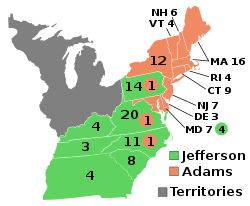| ||||||||||||||||||||
| ||||||||||||||||||||
| ||||||||||||||||||||
| Elections in Tennessee |
|---|
 |
The 1796 United States presidential election in Tennessee took place between November 4 and December 7, 1796, as part of the 1796 United States presidential election. It was the first presidential election that Tennessee had participated in since being admitted to the Union on June 1, 1796, as the 16th state. [1]
Tennessee voted for the Democratic-Republican candidate Thomas Jefferson over Federalist candidate, John Adams, but the exact election results are unknown. Jefferson did, however, win all three electoral votes. [2]
Tennessee used an electoral district system to choose its electors, with each district electing a single elector. This is similar to the way Nebraska and Maine choose their electors in modern elections. [3]


